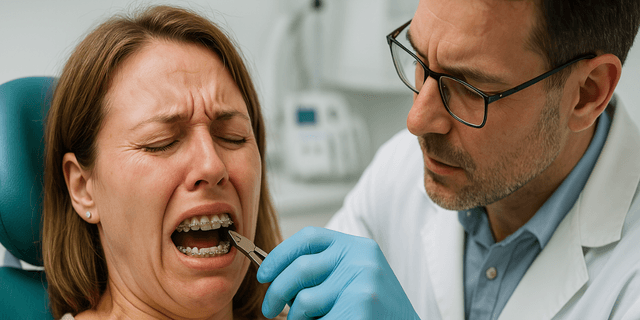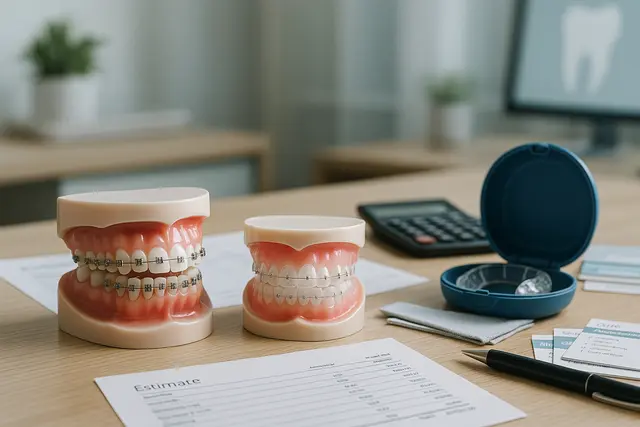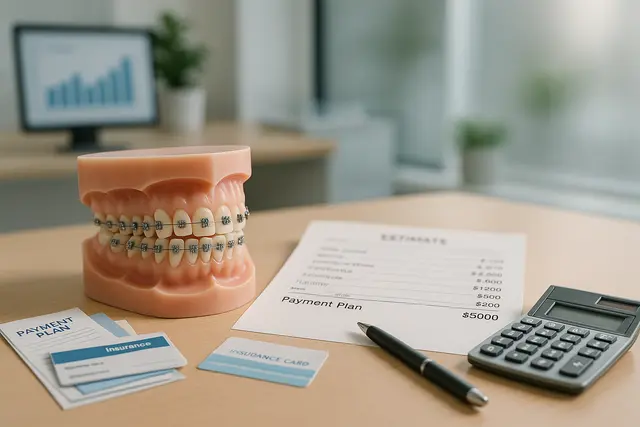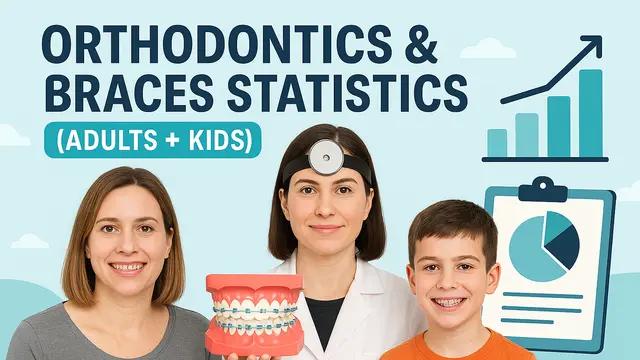Orthodontics
6 min read
Apr 03, 2025
Do Braces Hurt? What to Expect During Treatment and Adjustments
Getting braces changes how your mouth feels. Many people worry about pain when they start orthodontic treatment. The truth is that braces can cause discomfort, especially at first. The pressure they apply to your teeth is what helps them move, but the body takes time to get used to that change.

Why Braces Hurt (but Not as Much as You Fear)
Ask three friends “Do braces hurt?” and you will hear three different stories. Truth: braces usually hurt a little, never a lot, and the feeling changes as treatment moves along. Brackets and wires apply constant pressure on your teeth and gums to shift each tooth into proper alignment.
That pressure causes a mild ache, most noticeable during the first few days after getting dental braces and right after each visit when your orthodontist tightens the wire. Think of it as the dull throb you feel in sore muscles after a workout, annoying, yet proof the process works.
Understanding Braces Pain and Soreness
Braces pain often shows up as soreness around the tooth roots rather than a sharp zap. The periodontal ligaments stretch, tiny blood vessels dilate, and your immune system rushes in to remodel bone. You may experience a swollen gum line, a “loose-tooth” sensation, or tenderness when you bite down. Pain in the teeth peaks within a few hours after an adjustment, eases within a few days, and should subside entirely by the end of the week. If pain or discomfort lingers longer, call the office.
What Happens When Your Orthodontist Tightens the Wire
At every check-up the orthodontist swaps wires, shortens elastic bands, or changes the angle on a stubborn bracket. Each tweak restarts the biological dance that moves bone. Within a few hours you feel gentle pressure on your teeth, similar to meeting a firm handshake. The pain is usually a four on a scale of 1-10, and ice water, over-the-counter pain medications, or orthodontic wax reduce the sting. Remember, orthodontics is a marathon, not a sprint.
The Day You Get Braces: A Play-by-Play
When you first get braces, the chair feels like center stage. Your orthodontist cleans every tooth, bonds the brackets, threads the archwire, and secures elastic rings. New braces may hurt later that evening because brackets and wires may rub the inside of your cheeks. It is normal to experience some slight pain, but home remedies, saltwater rinses, soft foods like mashed potatoes, or a chilled spoon, make the new hardware easier to accept.
Working Hand-in-Hand with Your Orthodontist
Your orthodontist is your coach throughout the braces journey. They study tooth movement, gum health, and occlusion so the constant pressure on your teeth stays safe. Broken bracket? Call. Wire poking? Call. Braces can cause discomfort, but a two-minute fix in the clinic can stop braces pain before it ruins your weekend.
Smart Pain Relief Strategies That Actually Work
The best pain relief starts one hour before your appointment, take over-the-counter pain relievers with a light snack. Afterward, stick to soft foods for the first day, sip ice water, and chew sugar-free gum to boost circulation. Orthodontic wax over a sharp bracket prevents a sore patch on the inside of your cheeks, and a warm salt rinse soothes irritated tissue. Pain can be managed with small, consistent steps.
Braces Pain Relief Toolkit for Home and School
Pack orthodontic wax, floss threaders, mini interdental brushes, over-the-counter pain gel, and travel-size mouthwash in a zipper pouch. At school or work, you can pop to the restroom, cover a bothersome bracket, and keep your teeth happy without skipping class or a meeting. Braces pain relief is easier when supplies are within arm’s reach.
Daily Dental Care to Keep Teeth and Gums Happy
Brackets create nooks where sticky bits love to hide. Brush the tooth surface above and below the wire in tiny circles, then angle the bristles straight into each bracket. Use a water flosser or floss threader to sweep between teeth and gums. Clean hardware means less inflammation, less soreness, and faster results. Hard or sticky foods snap wires and rip brackets, so favor softer textures especially during the first few days after getting tightened.
Managing Pain and Discomfort After You Get Your Braces
Within a few days of placement, teeth may feel bruised when you chew. Switch to foods like scrambled eggs, yogurt, and blended soups. Over-the-counter pain relievers quiet throbs; orthodontic wax eliminates friction blisters; chewies help seat the wire. Dealing with braces pain becomes easier when you remember that discomfort after getting an adjustment signals your braces work by gradually encouraging bone remodeling.
Living With Brackets and Wires: Finding Your Groove
Once initial discomfort fades, you stop noticing the brackets and wires. You will adapt to your braces comfortably. People often forget they even wear braces until lunchtime spinach exposes itself on a bracket. Keep your teeth extra clean, attend every appointment, and enjoy watching gaps shrink in mirror selfies, evidence the system works.
Retainer Life: What Happens After the Brackets Come Off
Braces are removed once your orthodontist confirms every tooth sits where it belongs. The next chapter begins: retainer time. A retainer causes only light pressure on your teeth, nothing like the early days. Wear it exactly as instructed, skipping nights lets teeth drift and may hurt when you pop the retainer back in. Protect the investment you made in your smile.
Tackling Initial Discomfort and First-Week Challenges
The first week with new braces is the big hurdle. You may experience minor aches in the jaw, dryness from mouth breathing, or the urge to nibble forbidden popcorn. Suck on ice chips, use orthodontic wax, and remind yourself that pain from braces fades quickly. Within a few days you will bite pizza crust again without wincing.
How to Wear Braces Comfortably Long-Term
Small habits keep braces comfortably in the background: drink plenty of water, massage sore gums with a clean finger, and stretch facial muscles. Swapping soda for still water protects enamel etched by brackets. If elastic bands may hurt your cheeks, tuck cotton rolls at bedtime. These tweaks turn metal hardware into a forgettable accessory.
Why Braces Usually Hurt Less Than You Expect
Media myths say teenagers writhe in agony after every tightening, but most patients report only mild soreness. Braces do not hurt every minute; they pulse during adjustment and relax later. Pain and discomfort feel temporary because your brain adapts to predictable sensations. When pain stops your lunch, call the office, braces hurt on a scale of five or higher only if something is wrong.
Pain From Braces Versus Other Tooth Aches
Pain in the teeth caused by braces is different from a cavity’s sharp zap. Braces put gentle, even force on each tooth, whereas decay drills straight into the nerve. If pain feels electric or one tooth aches while neighbors stay calm, see your dentist for a decay check. Orthodontic treatment and general dental care work together to keep your teeth and gums healthy.
Discomfort After Getting Adjustments: How Long It Lasts
Expect tenderness for days to a week after each tightening. Foods for the first two evenings should squish easily with your tongue. Pain relief comes from cold smoothies, a heating pad against your jaw, and elastic exercise chewies. Most patients say braces stop hurting by breakfast on day four.
When Do Braces Stop Hurting? The Honest Timeline
You will feel tiny flares of soreness every visit, yet long stretches of comfort between. Braces typically become background noise by week three. After that, you remember them only when flossing or taking glamour-shot selfies with friends. The cycle repeats until the grand finale: wire out, retainer in.
Dealing With Braces Pain Day-to-Day
Braces may pinch, rub, or press, but pain can be managed. Stop braces pain early: carry wax, rinse with warm salt, and keep pain relief tablets handy. Using over-the-counter pain responsibly, avoiding hard pretzels, and checking wires daily lets you adjust to your braces without drama. If you’re considering braces, remember that braces do not hurt chronically. Pain is usually low-grade, manageable, and, best of all, temporary.
Do Braces Hurt When You First Get Them?
Yes, but the pain is usually mild and temporary. You may feel soreness or pressure a few hours after your braces are placed, similar to muscle soreness after a workout. This discomfort typically fades within a few days as your mouth adjusts.
Why Do Braces Hurt After Tightening?
Each adjustment increases pressure on your teeth to keep them moving into alignment. That added force can make your teeth and gums feel sore for a few days. Over-the-counter pain relievers, ice water, and soft foods help ease the discomfort.
How Long Does Braces Pain Last After an Adjustment?
Most people experience discomfort for 2 to 4 days after a tightening. The pain peaks within 24 hours and gradually fades. If soreness lasts longer than a week, or if it feels sharp or intense, contact your orthodontist.
What Can I Do at Home to Relieve Braces Pain?
Try rinsing with warm salt water, using orthodontic wax to cover irritating brackets, and sticking to soft foods like yogurt or mashed potatoes. Pain relievers like ibuprofen can help, and a cold compress can reduce inflammation on sore cheeks or jawlines.
Read Next
Related Posts

Orthodontics
Retainer That Looks like Braces: Benefits for Long-Term Alignment
A retainer might not get as much attention as braces, but it plays a crucial role in maintaining your smile after orthodontic treatment. Whether you're new to retainers or curious about the type that looks like braces, understanding their purpose and benefits is key to keeping your teeth aligned for the long haul.
6 min read
Sep 15, 2025

Orthodontics
How Much Are Metal Braces? Cost Comparison With Other Options
Thinking about getting braces but overwhelmed by the cost? You’re not alone. Orthodontic treatment can be a major investment, and understanding the different price points, from metal braces to clear aligners, can help you make a smart, confident decision.
5 min read
Sep 15, 2025

Orthodontics
Orthodontics & Braces Statistics (Adults + Kids)
Orthodontics has transformed from a niche medical service for teenagers into a booming sector that spans all ages. Today, both adults and children seek orthodontic treatment to improve their smiles, fix bite issues, and boost self-confidence.
4 min read
Aug 21, 2025
Don’t have time to research every dentist around you?
See why 30k+ patients trusted us